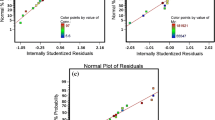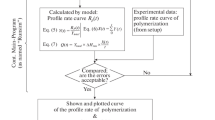Abstract
Optimization of operational conditions for the polymerization of propylene with Ziegler–Natta catalyst was carried out via RSM. Response surface methodology (RSM) based on a three-level, four-variable Box–Behnken design was used to evaluate the interactive effects of reaction conditions such as reaction temperature (60–80 °C), monomer pressure (5–8 bar), hydrogen volume (130–170 mL), and cocatalyst to catalyst ratio (Al/Ti, 340–500) on the catalyst activity and melt flow rate (MFR). The optimum reaction conditions derived via RSM were: temperature 70 °C, pressure 8 bar, hydrogen volume 151 mL, and cocatalyst to catalyst ratio 390. The experimental catalyst activity and MFR were 8 g polypropylene/mg catalyst and 10.9 g/10 min, respectively, under optimum conditions. Optimum values were determined from process cost point of view and offered better operational conditions.














Similar content being viewed by others
References
Soroush M, Kravaris C (1992) Nonlinear control of a batch polymerization reactor: an experimental study. AIChE J 38:1429–1448
Lundstedt T, Seifert E, Abramo L, Thelin B, Nyström A, Pettersen J, Bergman R (1998) Experimental design and optimization. Chemometr Intell Lab Syst 42:3–40
Mason RL, Gunst RF, Hess JL (2003) Statistical design and analysis of experiments with application to engineering and science, 2nd edn. Wiley, New York
Bezerra MA, Santelli RE, Oliveira EP, Villar LS, Escaleira LA (2008) Response surface methodology (RSM) as a tool for optimization in analytical chemistry. Talanta 76:965–977
Myers RH, Montgomery DC, Anderson CM (2009) Response surface methodology, process and product optimization using designed experiments, 3rd edn. Wiley, Hoboken, NJ
Khuri AI (2006) Response surface methodology and related topics. World Scientific Publishing Co, Pte. Ltd., Singapore
Hanrahan G, Lu K (2006) Application of factorial and response surface methodology in modern experimental design and optimization. Crit Rev Anal Chem 36:141–151
Aktas N, Boyaci IH, Mutlu M, Tanyolac A (2006) Optimization of lactose utilization in deproteinated whey by Kluyveromyces marxianus using response surface methodology RSM. Bioresour Technol 97:2252–2259
Otto M (1999) Chemometrics: statistics and computer application in analytical chemistry. Wiley-VCH, Weinheim
Ferreira SLC, Bruns RE, Ferreira HS, Matos GD, David JM, Brandão GC, da Silva EGP, Portugal LA, dos Reis PS, Souza AS, dos Santos WNL (2007) Box-Behnken design: an alternative for the optimization of analytical methods. Anal Chim Acta 597:179–186
Ghafari S, Aziz HA, Isa MH, Zinatizadeh AA (2009) Application of response surface methodology (RSM) to optimize coagulation–flocculation treatment of leachate using poly-aluminum chloride (PAC) and alum. J Hazard Mater 163:650–656
Kissin YV (2008) Alkene polymerization reactions with transition metal catalysts. Elsevier, Amsterdam
Pater TM, Weickert G, Van Swaaij PM (2003) Polymerization of liquid propylene with a fourth-generation Ziegler–Natta catalyst: influence of temperature, hydrogen, monomer concentration, and prepolymerization method on powder morphology. J Appl Polym Sci 87:1421–1435
Kissin YV, Ohnishi R, Konakazawa T (2004) Propylene polymerization with titanium-based Ziegler-Natta catalysts: effects of temperature and modifiers on molecular weight, molecular weight distribution and stereospecificity. Macromol Chem Phys 205:284–301
Kissin YV, Mink RI, Nowlin TE, Brandolini AJ (1999) Kinetics and mechanism of ethylene homopolymerization and copolymerization reactions with heterogeneous Ti-based Ziegler–Natta catalysts. Top Catal 7:69–88
Kaminsky W (1999) Metalorganic catalysts for synthesis and polymerization. Springer, Berlin
Kissin YV, Rishina LA (2002) Hydrogen effects in propylene polymerization reactions with titanium-based Ziegler–Natta catalysts. I. Chemical mechanism of catalyst activation. J Polym Sci Part A: Polym Chem 40:1353–1365
Belelli PG, Eberhardt A, Dos Santos JHZ, Ferreira ML, Damiani DE (2003) In: Pandalai SG (ed) Recent research developments in polymer science, vol 7. Transworld Research Network, Kerala, India, p 223
Kissin YV, Rishina LA, Vizen EI (2002) Hydrogen effects in propylene polymerization reactions with titanium-based Ziegler–Natta catalysts. II. Mechanism of the chain-transfer reaction. J Polym Sci Part A: Polym Chem 40:1899–1911
Author information
Authors and Affiliations
Corresponding author
Rights and permissions
About this article
Cite this article
Nassiri, H., Arabi, H., Hakim, S. et al. Polymerization of propylene with Ziegler–Natta catalyst: optimization of operating conditions by response surface methodology (RSM). Polym. Bull. 67, 1393–1411 (2011). https://doi.org/10.1007/s00289-011-0568-y
Received:
Revised:
Accepted:
Published:
Issue Date:
DOI: https://doi.org/10.1007/s00289-011-0568-y




